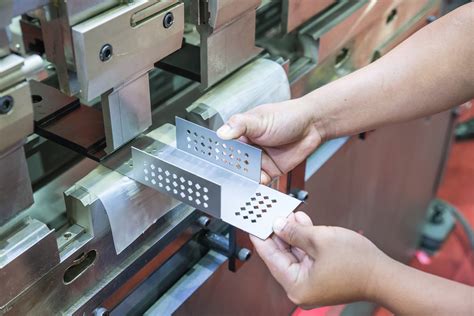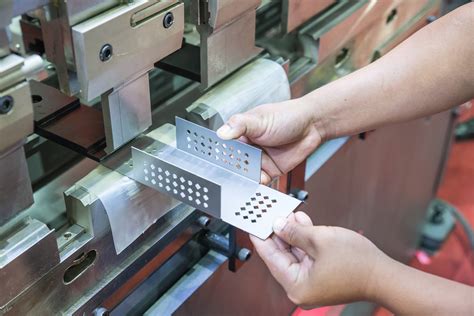sheet metal manufacturing process slideshare Bending Processes 1. ‘V’ Bending: One of the most common types of sheet metal manufacturing processes is V bending. The V shaped punch forces the work into the V shaped . Sigma's weatherproof two-gang boxes provide a junction for conduits and can house up to two wired devices such as a receptacle or switch. The rugged, die-cast construction prevents moisture penetration making the boxes suitable for wet, damp or dry locations.
0 · types of sheet metal fabrication
1 · sheet metal manufacturing techniques
2 · sheet metal manufacturing process types
3 · sheet metal manufacturing news
4 · sheet metal layout techniques
5 · how to fabricate sheet metal
6 · disadvantages of sheet metal
7 · basic sheet metal fabrication techniques
Suitable for holding various pipes or rods like PVC. The screw hole diameter is .
types of sheet metal fabrication
Bending Processes 1. ‘V’ Bending: One of the most common types of sheet metal manufacturing processes is V bending. The V shaped punch forces the work into the V shaped .This document discusses various sheet metal processes including cutting, .
sheet metal manufacturing techniques
Sheet Metal Working & Process. Feb 17, 2016 •. 67 likes • 16,433 views. .
This document discusses various sheet metal processes including cutting, forming, bending, drawing, and stretching operations. Some key points: 1. Sheet metal work involves forming metal sheets 3-5mm thick into parts .
This document discusses sheet metal processes. It begins by defining sheet metal working as a chipless manufacturing process that forms various components from sheet metal using punching and other forming .
3 Sheet metal processing. The raw material for sheet metal manufacturing processes is the output of the rolling process. Typically, sheets of metal are sold as flat, rectangular sheets of standard .
This process can be made by means of matched male and female roller dies, or by passing sheet or a strip of metal between rolls of the desired pattern. It is . Sheet Metal Working & Process. Feb 17, 2016 •. 67 likes • 16,433 views. Velmurugan Sivaraman. Follow. Roll forming Long parts with constant complex cross-sections; good surface finish; high production rates; high .
The process of producing sheet metal components using metal sheets is known as sheet metal forming or sheet metal fabrication. This is accomplished by bending, punching, shearing, hydroforming, and other .
sheet metal manufacturing process types
Sheet metal manufacturing is the process of creating sheet metal parts by cutting, bending, and forming thin metal sheets into specific shapes and sizes. The process typically uses coating, cutting, bending, and assembly techniques. Sheet metal working involves cutting, bending, drawing, and other forming operations to shape metal sheets. The processes include shearing, blanking, and punching, with various tools like punches and dies. Clearance, . Sheet Metal Forming Process and Their Application. Sheet metal forming process is carried out in the plane of the sheet by tensile forces with a high ratio of surface area to thickness. The high rate of production and . 1. SHEET METAL PROCESSES Sheet metal characteristics - Typical shearing operations, bending and drawing operations – Stretch forming operations –– Formability of sheet metal – Test methods – Working principle .

8. SHEARING • It is a process of cutting a straight line across a strip, sheet • Metal is placed between upper punch & lower die. • Pressure is applied, plastic deformation takes place. • As the pressure is continued, the . 4. 1.0 Introduction Sheet metal is simply metal formed into thin and flat pieces. Sheet metal is essentially metal pressed into sheets. These sheets are used at various places. These sheets can be bent, cut and molded into . Confidential5 Stamping • body panels, doors, hoods, floor pans and other parts are stamped out of sheet metal • Fully automated transfer presses cut out blanks from the metal sheets. • Laser welding consists in assembling metal sheets each having a different thickness or strength, into one part.
1. Metal forming processes Metal forming: Large set of manufacturing processes in which the material is deformed plastically to take the shape of the die geometry. The tools used for such deformation are called die, punch etc. depending on the type of process. Plastic deformation: Stresses beyond yield strength of the workpiece material is required.
Shear Spinning • A sheet metal blank is placed between the mandrel and the tailstock of the spinning machine. The mandrel has the interior shape of the desired final component. • A roller makes the sheet metal wrap the mandrel so that it takes its shape. • As can be seen, s1 which is the initial wall thickness of the work piece is reduced .
1. Manufacturing Process - I UNIT –IV Metal Joining Processes Prepared By Prof. Shinde Vishal Vasant Assistant Professor Dept. of Mechanical Engg. NDMVP’S Karmaveer Baburao Thakare College of Engg. Nashik Contact No- 8928461713 E mail:- [email protected] site:- www.vishalshindeblog.wordpress.com PROF.V.V.SHINDE . Additive manufacturing, also known as 3D printing, involves building 3D objects layer by layer from digital models. The document discusses the current state and future potential of 7 additive manufacturing processes, including stereolithography, material jetting, binder jetting, material extrusion, powder bed fusion, sheet lamination, and directed energy deposition. 10. Nibbling • The nibbling process cuts a contour by producing a series of overlapping slits or notches. This allows for complex shapes to be formed in sheet metal up to 6 mm (0.25 in) thick using simple tools. • Punches are available in various shape and sizes; oblong and rectangular punches are common because they minimize waste and allow for greater . 24. Comparison of representative Parts: Aero and Auto Auto Aero Part Description Body Panel Body Panel 54"X54" 54"X54" Forming Process Progressive Stamping Stretch Forming MATERIAL Material 1010 Steel, cold-rolled, .04" sheet, custom order double-sided Zinc clad 2024 Aluminum, T3 temper, .08" sheet, oversize mechanically polished Scrap 40% 20% .
Metal-Forming Process for Beverage Can Steps in Manufacturing an Aluminum Can The metal-forming processes involved in manufacturing a two-piece aluminum beverage can Lecture-05: Sheet Metal Forming Processes 34/31 This document describes various manufacturing processes used to produce finished products from raw materials. It discusses 5 main categories of processes: 1) shaping processes like casting and forging that change the shape and size of materials, 2) machining processes like turning and milling that remove material, 3) joining processes like welding and .
MICRO FORMING IN SHEET METAL PROCESSES It is well known that the sheet metal thickness is between 0.4 and 6 mm but while micro-sheet forming usually handles the sheet metals of which the thickness is less than 0.3 mm. Therefore, it is called as thin strips or coils. The major sheet processes in micro sheet forming are shearing, cutting, bending . 10. 10 10 CONFIDENTIAL Metal Stamping manufacturing is the process of creating metal parts by applying extreme pressure to a blank piece on metal and forming the metal into a desired shape Corners should have a minimum radius of 0.5 x material thickness or 0.4 mm (0.016in) whichever is greater. Sharper corners can be produced but at a greater die . 5. Contd.. Romen et. al studied that the spring back's increasing classical trends are related to radius decrease, yielding stress increase, bending radius increase and Young’s modulus decrease. Tan et.al studied that due to . Sheet Metal Working »Sheet Metal Bending 05-10-2020 MEC323: PRIMARY MANUFACTURING (Dr. L K Bhagi) 60 Bending of sheet metal is a common and vital process in manufacturing industry. Sheet metal bending is .
sheet metal drawers
Steel manufacturing process - Download as a PDF or view online for free. Submit Search. . If the metal requires cooling, scrap steel is added. If the temperature is too low, aluminum is added and oxygen blown through. .

SHEET METAL The raw material for sheet metal manufacturing processes is the output of the rolling process. Typically, sheets of metal are sold as flat, rectangular sheets of standard size. . NOTCHING Notching is a metal-cutting process used on sheet metal or thin bar stock, sometimes on angle sections or tube. A shearing or punching process . 5. • Aluminum is also a popular metal used in sheet metal due to its flexibility, light weight, and cost effectiveness • Most common Grade 3003- H14 is fairly strong, while maintaining the same formability and low cost. It is corrosion resistant and weldable. It is often used in stampings, spun and drawn parts, and fan blades • Brass is an alloy of copper, which is widely .
The bottom of the piece is then punched out to produce a “T.” (c) Manufacturing of Bellows. Sheet Metal Forming Processes 34/23 24. Stretch Forming In stretch forming, the sheet metal is clamped around its edges and stretched over a die or form block, which moves upward, downward or sideways, depending on the particular machine. Stretch .
sheet metal manufacturing news
Rolling is a metal forming process where metal stock is passed through one or more pairs of rolls to reduce the thickness and increase the length. . two-high, three-high, four-high and cluster/sendzimir mills. Continuous mills use multiple stands to continuously roll sheet metal. Read less . , Butterworth Heinemann, ISBN 0-7506-2754-9 . Economics of Sheet-Metal Forming Spinning 8 7 6 5 4 3 2 FIGURE 7.72 Cost comparison for manufacturing a cylindrical sheet-metal container by conventional spinning and deep drawing. Note that for small quantities, spinning is more economical.
sheet metal layout techniques
METAL JOINING PROCESS - Download as a PDF or view online for free . 19 likes • 2,282 views. L. laxtwinsme Follow. Manufacturing Technology 1 - Welding Operating principle, basic equipment, merits and applications of: Fusion welding processes : Gas welding - Types – Flame characteristics; Manual metal arc welding – Gas Tungsten arc . This presentation is for academic purpose Topics:- 1) Metal forming 2) Stress- strain analysis for forming process 3) Hot working and cold working process 4) Rolling process 5) Rolling mill arrangements 6) Rolling defects 7) Ring rolling 8) Thread rolling 9)Seamless Pipe Manufacturing By Rolling Process 10) Production of Steel Balls by Rolling Process 11) Roll . Various manufacturing system designs are presented, including job shop, flow shop, linked-cell shop, and project shop configurations. Common basic manufacturing processes like casting, forming, machining, joining, and rapid prototyping are summarized along with examples. The roles of engineers in manufacturing are also outlined. Read less • The sheet material is subjected to a bending operation. The sheet is bent over the corner of the punch and the corner of the die. •As the punch continues moving down, a straightening action occurs in the metal that was previously bent over the die radius. Metal from the flange is drawn into the die opening to form the cylinder wall.
4. Forming/Metal Forming Forming or metal forming, is the metalworking process of fashioning metal parts and objects through mechanical deformation; the workpiece is reshaped without adding or removing material, and its mass remains unchanged. Forming operates on the materials science principle of plastic deformation, where the physical shape of a material is .
how to fabricate sheet metal
Shop Philips 7.5' Twinkle Tree Pre-lit Balsam Fir Artificial Christmas Tree with 2000 Multifunction, Dual Color LED Lights, Remote Control, and Dimmer at Target. Choose from Same Day Delivery, Drive Up or Order Pickup. Free standard shipping with $35 orders.
sheet metal manufacturing process slideshare|sheet metal manufacturing techniques